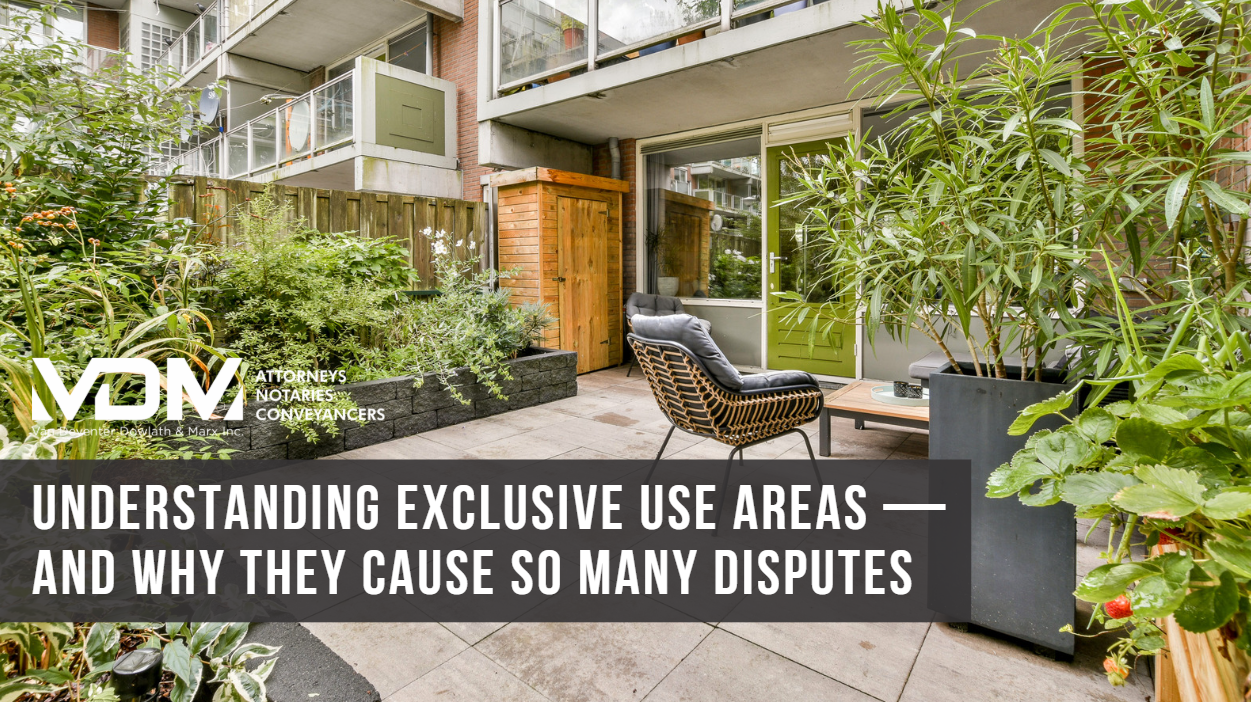
In sectional title living, space is shared - but not always equally. That’s where the concept of Exclusive Use Areas (EUAs) comes in. These are parts of the common property that are set aside for the exclusive use of one or more owners, such as parking bays, gardens, or patios.
It sounds simple - but in practice, EUAs are one of the most misunderstood and disputed aspects of sectional title ownership.
What Exactly Is an Exclusive Use Area?
Under the Sectional Titles Schemes Management Act (STSMA), an Exclusive Use Area is a portion of common property (like a garden, driveway, or balcony) that remains owned by the body corporate but is reserved for the private use of one owner.
There are two legal ways this can happen:
- Registered Exclusive Use - created by a Notarial Deed and reflected on the sectional plan. This is the most formal and secure method.
- Rule-Based Exclusive Use - granted through the management or conduct rules, approved and filed with the CSOS.
Both give an owner the right to exclusive use - but the way they’re recorded, transferred, and managed differs significantly.
Why So Many Disputes Arise
- Unclear Ownership and Boundaries
Many owners assume they own their parking bay or garden, when in fact it’s common property. If it’s not clearly marked or legally recorded, boundaries become a breeding ground for conflict.
- Old or Unregistered Agreements
Some older complexes were developed before the current legislation came into effect. As a result, certain “exclusive use” areas were agreed informally - but never legally registered or approved by CSOS. When new owners move in, they often inherit a verbal understanding that carries no legal weight.
- Maintenance Responsibilities
Who fixes the paving in your exclusive-use parking bay - you or the body corporate? The answer depends on how the area was created and what the rules say. Poorly written or outdated rules often leave this open to interpretation, sparking frustration and special levies.
- Levy Contributions and Fairness
Owners who don’t have EUAs sometimes argue that those who do should pay higher levies or exclusive-use contributions. This can create tension, especially in smaller schemes where the costs feel more personal.
- Mismanagement or Unauthorised Use
Trustees sometimes grant or revoke exclusive use areas without following the proper process - or owners start using common areas as private space without permission. Both can lead to CSOS disputes, neighbour conflict, and even litigation.
How to Prevent These Problems
- Verify your rights: Check whether your EUA is registered on the sectional plan or only granted in the rules.
- Clarify maintenance duties: Update your conduct rules to specify who maintains what.
- Keep your records clean: Ensure that all EUAs are properly documented, numbered, and allocated.
- Don’t make informal arrangements: Always have any exclusive use area created or amended through the correct legal process.
- Review your scheme rules regularly: Laws and interpretations evolve, so your rules should too.
How VDM Attorneys Can Help
Exclusive Use Areas sit at the intersection of property rights, governance, and neighbour relationships - and they require careful drafting to get right.
VDM Attorneys specialises in:
- Drafting and registering Exclusive Use Areas correctly;
- Updating scheme rules to ensure CSOS compliance;
- Advising on disputes or boundary issues; and
- Providing legal opinions for trustees, developers, and managing agents.
Before small misunderstandings turn into big disputes, let our sectional title specialists help your scheme achieve clarity and peace of mind.
📩 Contact Johlene Wasserman ([email protected]) at VDM Attorneys today to review your Exclusive Use Areas and ensure your governance is watertight.